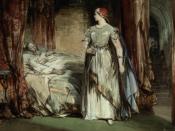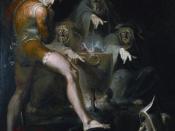Throughout William Shakespeare's extremely insightful play, Macbeth, a enormous multitude of themes and symbols present themselves to the engaged reader. Intriguingly, all of these themes perfectly correspond to the plethora of other themes illustrated in the multitude of novels which we have read earlier this year. Thus, this book appears as a perfect close to this exciting year, for all of the themes which we have so meticulously analyzed before are now conclusively being brought together into a final decisive statement.
One of the most intriguing and all-encompassing themes present in act 1 of Shakespeare's Macbeth is the sharp contrast between good and bad, light and dark, and foul and fair, such as when the witches state "the battle's lost and won (I.I.4)." Furthermore, this themes ties in with the another intriguing theme, the fact that it is horrible to judge someone strictly by their outer appearance. For example, in Jeanne Johnson's enticing excerpt, Fair and Foul are Near of Kin, this theme is unmistakably exemplified through the twins, the Eva, and the old man.
The excerpt describes two twins, one of whom possesses both blonde hair and blue eyes, the other of which possesses dark hair and brown eyes. Corresponding to the title of the story, the blonde haired boy, Roger, can be considered fair, just like all people who express these same physical traits. However, the darker boy can be seen as the foul one, for he has dark skin, which is hated by Eva due to his lack of similar traits to her own, and possibly, racial discrimination. Eva locked the darker child up due to his outer appearance, even though she never got to understand his true personality, for how can someone associate with another person behind locked doors? The fairer boy, Roger, however, was treated...


